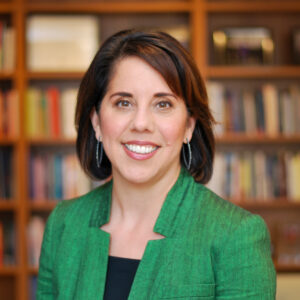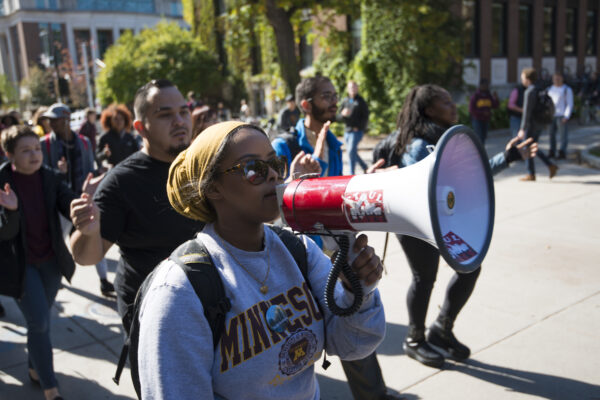Lorelle Espinosa, Hollie Chessman and Lindsay Wayt of ACE’s Center for Policy Research and Strategy on how presidents have responded to recent student protests and demands for campus diversity and inclusion. This post is the latest in a series on the topic of campus climate.
Black Lives Matter. In addition to crystalizing a movement, these three words encapsulate well the current state of race relations in the United States.
As microcosms of society, college and university campuses are experiencing their own era of racial awareness, tension and unrest. Front and center in this movement are recent student protests focused broadly on social justice, and more specifically on campus diversity and inclusion.
Similar to demonstrations in the 1960s—perhaps the last time higher education has seen student activism at the current scale—students have targeted their messages toward campus leaders; namely, college and university presidents and other senior administrators. Yet while student voices have been heard, both through the more than 75 sets of demands and a growing number of profiles of individual student activists, we know less about the experiences and perceptions of those at the helm of our nation’s postsecondary institutions.
With this in mind—and in recognition of the paramount role of presidential leadership on issues of inclusion—ACE’s Center for Policy Research and Strategy fielded its first national Pulse Point anonymous online survey of college and university presidents in mid-January to better understand their experiences, perceptions and (re)actions on the timely issue of campus racial climate. We received a response from 567 college and university presidents, the majority of whom have led their respective institutions for four or more years. [1]
Here’s what we found.
Student Organizers and the Influence of High-Profile Events
Nearly half of four-year presidents and 13 percent of two-year presidents indicated students on their campus have organized around concerns about racial diversity. Just over 50 percent of students at public four-year institutions have organized, compared to 45 percent at private four-year institutions. And the vast majority of presidents who said students had organized indicated meeting with organizers on more than one occasion.
Seventy-five percent of four-year presidents and 62 percent of two-year presidents believe high-profile events (e.g., those related to #BlackLivesMatter, immigration, Islamaphobia) increased the campus-wide dialogue or dialogue within certain groups. As one president wrote, “The national issues have manifested at my campus as a genuine focus on eliminating the disparity in student academic achievement by ethnicity and on being more proactive in diversifying the faculty.”
Actions Taken
Racial climate is a priority for college and university presidents, with 44 percent of two-year and 55 percent of four-year presidents expressing that it is a higher priority than it was just three years ago.
We asked presidents about actions their campuses have taken in recent years based on student concerns for racial diversity, using findings from our previous analysis of student demands. The most prominent action over the last five years, for both two-year and four-year institutions as well as public and private institutions, has been initiatives aimed at increasing diversity among students, faculty and/or staff. Some interesting differences occur between private and public institutions, with the latter having taken the most action in the past five years.

A number of presidents also indicated that racial climate has been a priority on their campus for years and even decades, and thus is the same priority as it has been in the past. As one president wrote, “We experienced our campus ‘flashpoints’ earlier than many others, and as a result, had much good work already underway when we saw unrest take place nationally last fall… I believe that continuous dialogue between students and administration for well over a year has helped build trust; although the early dialogue was quite painful for us all to experience.”
Looking to the future, presidents say their campuses will develop diversity/cultural competency training for students, faculty, and/or staff and will revise or redevelop curriculum with an eye toward diverse perspectives.
Where Presidents Turn and How They View Campus Constituents
Approximately half of presidents at four-year institutions (66 percent at public four-year institutions and 39 percent at private four-year institutions) said they have a full-time administrator dedicated to student diversity on campus, such as a chief diversity officer. Roughly one quarter of two-year presidents said they have a dedicated diversity officer.
The two senior administrators that presidents lean on most when it comes to addressing racial diversity among students are their vice president of student affairs and/or dean of students and their campus’ diversity officer. For those who don’t have the latter, they lean even more so on their senior student affairs leader.
It is important to note that multiple presidents commented that they also rely on non-senior student affairs professionals, campus-wide diversity committees and legal counsel in addressing these issues.
How presidents engage others is perhaps as important as whom they engage. As one president said, “Staying in close touch with those I serve is critically important. I use face-to-face meetings of various sizes, open forums, social media, and regular written messages to the campus. Maintaining a healthy campus climate where everything thrives requires hard work and openness to diverse perspectives every day.”
Overall, presidents of two- and four-year institutions “strongly agree” or “agree” that their staff, faculty and governing boards are aware or sensitive to the need for racial diversity and inclusion, with some slight differences between the two sectors.
While their outlook on campus constituents is largely positive, many presidents mentioned the challenge of diversifying the faculty and ensuring the presentation of diverse perspectives in the classroom. One president wrote, “Our typical student is an urban young man of color. Faculty and other staff are mostly white and middle class. I’d like greater consciousness among staff and more dialogue in the community about race.”
As communities of color continue to grow in the United States, and as we continue to wrestle with the role of race in American society, colleges and universities will remain in a position to engage, respond and shape the dialogue on what it means to equitably educate an increasingly diverse populace. This is not a new role for higher education, but it has perhaps never been more important. As one president wrote, “Racism is still a major issue in American society, and it is no surprise that it should be within American higher education. The upsurge at some colleges of Black students should not surprise anyone or alter what we already need to do as leaders – continue to work on the problems of our society.”
A full report of our survey’s findings will be available later this year.
[1] Of the 567 college and university presidents that responded to the survey, 77 percent are leaders of four-year institutions (37 percent public and 63 percent private) and 23 percent are leading two-year institutions (91 percent are public; 9 percent are private). Regarding institution size, nearly half of presidents report leading institutions of 2,999 undergraduates or less, about one third lead institutions of 3,000-9,999 undergraduates, and about a quarter lead institutions with an undergraduate enrollment of over 10,000.
If you have any questions or comments about this blog post, please contact us.













